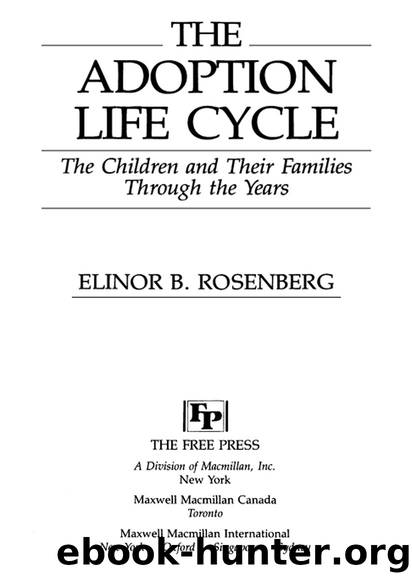The Adoption Life Cycle by ELINOR B. ROSENBERG

Author:ELINOR B. ROSENBERG
Language: eng
Format: epub
Publisher: The Free Press
Published: 1992-07-15T00:00:00+00:00
PHASE 5: SCHOOL YEARS
As children reach school age, they make significant shifts in their cognitive abilities and are able to understand some concepts previously beyond them. The noted developmental psychologist Piaget speaks of this as the emergence of “operational” functions. Through both physical maturation and experience, the child becomes increasingly able to understand causal relationships and think planfully and logically. 3 If children have been told of their adoption earlier, they will now begin to rework this information and their prior conclusions. There may continue to be vestiges of these earlier themes or beliefs as well as the feelings associated with them. The child who thought she had been put up on a shelf may maintain some sense of being “off-limits.” The blond-haired boy may always feel that his hair makes him unusual in some way.
If told of adoption during the school-age phase, children are able to understand that they have two sets of parents, one biological and one adoptive. The news upsets a basic belief in the inviolability of the parent-child tie. Ironically, a secure attachment to adoptive parents makes the news of relinquishment even more difficult to understand. An adoptee might think, “If parents are attached to their children the way my adoptive parents are attached to me, how can it be that parents would give a child away? Everything was fine. Why would they tell me something like this and make it all so confusing?” For the child, some basic tenets of human nature and sense of well-being are disrupted. Some children become noticeably distressed at the news and reflect this distress emotionally and behaviorally. Some muster immediate defenses, convincing themselves that being adopted is as good as or better than not being so. In all cases the news is recognized as significant, and the children begin the process of making their own sense of it.
In a child’s manner of thinking, if something bad happens it must be somebody’s fault. Adopted children begin to struggle with feelings about the whole cast of characters in the adoption circle, including themselves. They experience mixed feelings toward each set of parents and toward themselves. Sometimes they split these feelings by making one party good and the other bad, either consistently or alternately. Other players in the adoption drama may also be implicated: doctors, lawyers, and social workers may be seen as the ones who did good or bad deeds, thus protecting the primary characters. A child may ponder the nature and motives of everyone involved: “Was the birth mother a good mother who gave a bad baby away, or was I a good baby and she a (very) bad mother? Maybe she was good and I was good and my adoptive parents were bad in stealing me from her. Maybe somebody else stole me from her and sold me to them. Some days I think I was bad; some days I think those other people were bad.”
School-age years are a time when all children have fantasies about their origins. Now they are beyond the immature stage of seeing their parents as all-knowing and all-powerful.
Download
This site does not store any files on its server. We only index and link to content provided by other sites. Please contact the content providers to delete copyright contents if any and email us, we'll remove relevant links or contents immediately.
| Anthropology | Archaeology |
| Philosophy | Politics & Government |
| Social Sciences | Sociology |
| Women's Studies |
Cecilia; Or, Memoirs of an Heiress — Volume 1 by Fanny Burney(32068)
Cecilia; Or, Memoirs of an Heiress — Volume 3 by Fanny Burney(31463)
Cecilia; Or, Memoirs of an Heiress — Volume 2 by Fanny Burney(31413)
The Great Music City by Andrea Baker(30794)
We're Going to Need More Wine by Gabrielle Union(18641)
All the Missing Girls by Megan Miranda(14767)
Pimp by Iceberg Slim(13787)
Bombshells: Glamour Girls of a Lifetime by Sullivan Steve(13692)
Fifty Shades Freed by E L James(12923)
Talking to Strangers by Malcolm Gladwell(12887)
Norse Mythology by Gaiman Neil(12847)
For the Love of Europe by Rick Steves(11544)
Crazy Rich Asians by Kevin Kwan(8894)
Mindhunter: Inside the FBI's Elite Serial Crime Unit by John E. Douglas & Mark Olshaker(8708)
The Lost Art of Listening by Michael P. Nichols(7169)
Enlightenment Now: The Case for Reason, Science, Humanism, and Progress by Steven Pinker(6878)
The Four Agreements by Don Miguel Ruiz(6324)
Bad Blood by John Carreyrou(6283)
Weapons of Math Destruction by Cathy O'Neil(5842)
